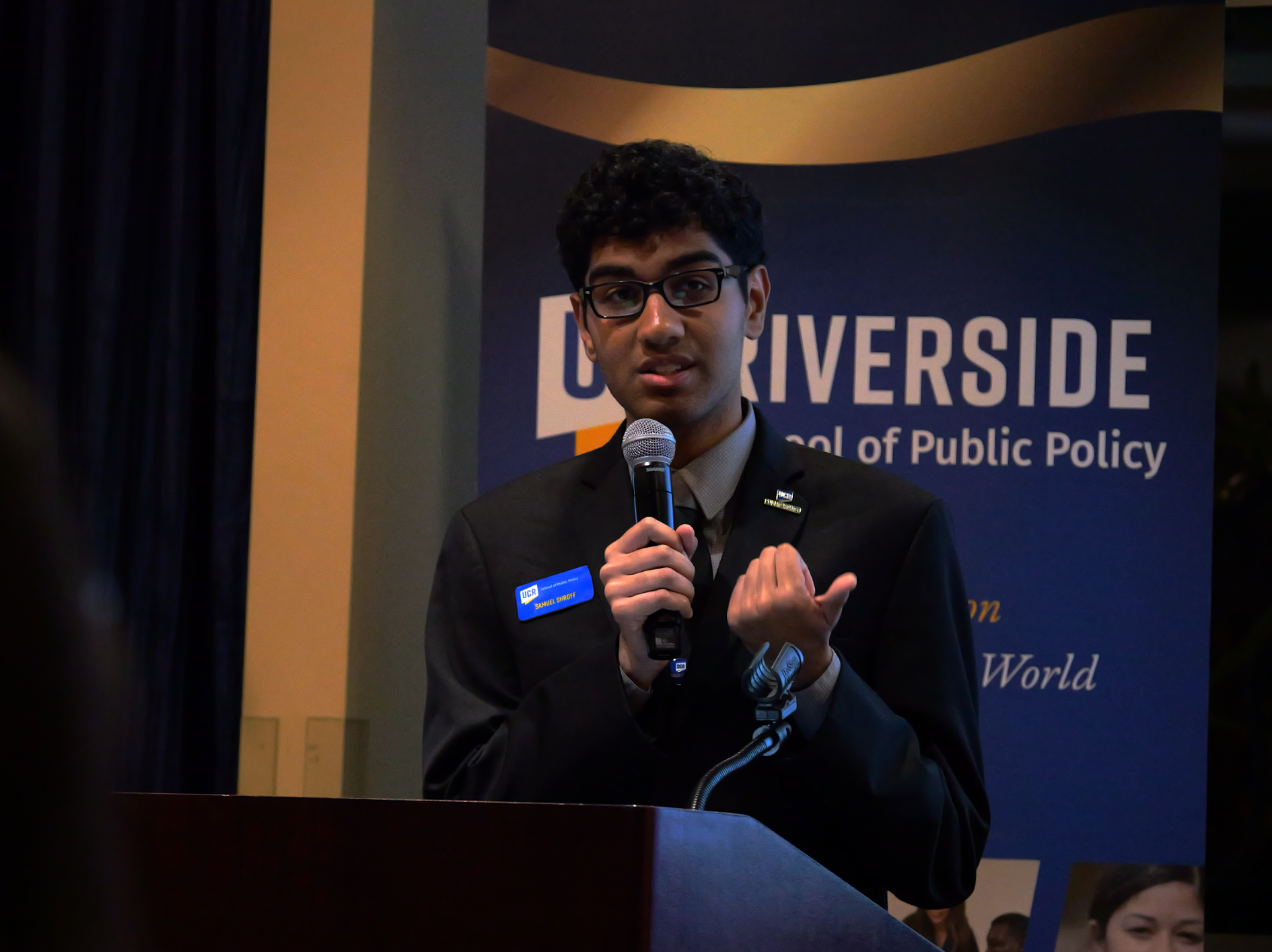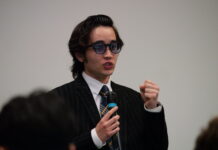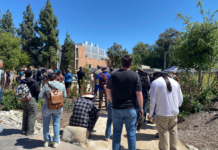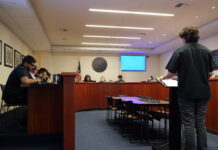
Mamata Elangovan / The Highlander
The University of California, Riverside’s (UCR) School of Public Policy (SPP) hosted an event in its Student Spotlight series, titled Creating Common Ground and Breaking Filter Bubbles, on Thursday Nov. 16. SPP’s Student Spotlight series aims to highlight students’ work. UCR students Divya Bharadwaj, Andrew Shannon and Samuel Shroff presented on the various tasks and responsibilities they took on as research assistants at AllSides Technologies as well as the company in general.
AllSides shows what content is left-leaning, right-leaning, or center. On the AllSides website, they are described as a company that “expose[s] people to information and ideas from all sides of the political spectrum so they can better understand the world.”
Miriam Fadel, an incoming Dean’s Vice Chief Ambassador of SPP, served as the event’s host and introduced John Gabel, the CEO and co-founder of AllSides, as the night’s first speaker. “The stuff we’re doing together at UCR really is unique…but we’re really doing something that can have a serious impact in society longer term,” Gable said.
Gable began with his experience at Netscape, “the first popular internet browser,” saying how the internet allowed people to find a multitude of information from across the world.” He went on to say, “We have a worldwide crisis [in] credibility. We don’t know what to believe anymore … And [we’re so] overwhelmed by a pure group that believes in one thing [and is] manipulated by [another] group.”
Gable discussed his inspiration for AllSides and its mission to display whether content is left-leaning, center, or right-leaning. Working in the early stages of the internet, Gable found that the internet was not enabling individuals to make better decisions, but rather “It’s making it harder for us to connect and harder for us to understand each other. I frequently describe it [as] making us confidently ignorant, because we see one point of view … [which] the algorithms think that I’ll be most likely to click on … And we see that one point of view 1000 times and so we’re absolutely positive it’s correct.”
For UCR students, Gable believes that they have the opportunity to avoid looking at one take on an issue “because you have a diversity of people here.” He further explained, “I’m finding that in the last two, three years, [students] are more concerned about the internet or even Wikipedia results misleading them or trying to get them to believe one thing over the other … I think you all are more set to be media literate than frankly just graduates three years ago.”
Touching upon the role that the UCR research assistants play, Gable explained how with the help of technology, assistants manually research an issue’s main arguments and the different points of view people believe in. Once these arguments are collected, the assistants can include the various stances an issue has and leave it up to the audience to decide for themselves what they think about that issue.
This draws upon the company’s use of Media Bias Ratings that Henry A. Brechter, Editor-in-Chief of AllSides, spoke about. “Basically, these allow you or anyone to easily identify different perspectives so you can get the full picture of issues and think for yourself,” Brechter said. A recorded video showed how AllSides uses an editorial team, third-party data and surveys to determine whether a form of media is left, center, or right.
Andrew Shannon, a second-year majoring in public policy, discussed AllSide’s focus on media filter bubbles and their mission to break them apart. “We seek out information that reaffirms our pre-existing beliefs.” Shannon believes that if individuals were to sit down with someone with opposing views and converse, it can “create impactful changes in our society.”
“We need to be comfortable with our differences,” said Gable on how these conversations could benefit the public. He then explained that by viewing different perspectives about the same news story, readers would be growing their media literacy on their own. “We want to enable people to decide for themselves. So that means we all need to have media literacy and by giving information to people in that way, they accidentally discover and grow their own critical thinking [and] their own media literacy skills,” Gable expanded.
Samuel Shroff, a second-year majoring in public policy, wrote that he focuses his research on “translating complicated policy issues into something that people can understand without having the same background or putting in the same effort as I did.” During his presentation, Shroff spoke about AllStances, articles written by the research assistants, and their approaches when creating such content such as “demystifying current issues” and “[getting] all sides of an argument.
With regard to their technological tools, “AllStances was built with artificial intelligence (AI) very much in mind,” said Shroff. He continued by saying that AllSides uses AI “as a very basic research tool.” When doing research on topics, the AI provides the team with various articles as sources. These sources are later verified as Shroff states that “It’s our job to go back and find the person who said that and make sure that they’re properly credited. That’s also another good vetting procedure because we can also catalog potential biases while we’re doing that.”
Shroff described the process behind AllStances writing, including finding what issues are important to the general public, finding the biased groups of such issues when doing research, discussing arguments in an unbiased manner when creating the content and having those with opposing views look at the content to determine the issues’ facts.
Divya Bharadwaj, a second-year majoring in public policy, spoke about the four AllStances articles the research assistants have created, all looking into political topics such as gun control, abortion regulation, Supreme Court Justice term limits and assault weapons. Bharadwaj also discussed her role in exploring AllSides’ methods of connecting to its audience, including through surveys. “We ask if we missed anything in said AllStances and for our audience members to look into more detail and provide us more feedback; as well as how we can move forward in improving our work.”
AllSides also uses social media to connect with its audiences, Bharadwaj explains. “I’ve been working on developing Instagram reels for this project in order to provide our audience with definitions of key terms; as well as a summary of each of AllStances’ core arguments.”
Attendees from the event expressed various views on the presentation. Tiffany Trieu, second-year political science major, said, “It’s just really nice to see that they’re [research assistants] trying to deal with issues in media and everything that’s kind of creating biases that are making our society more polarized” when commenting their thoughts on the presentation.
Pratika Prasad, a second-year majoring in political science, commented, “This is my first time at a public policy event … It is so inspiring to see your own peers go above and beyond your research, working with actual companies to put out non-biased information.” Prasad further said how beneficial it was for her to learn about the different perspectives the research team has.
An anonymous attendee shared their concerns regarding what was presented. “I was concerned with, ironically, the bias, and how the information about the company was presented in that it felt like they were trying to sell me a program or a product of some kind rather than explain to me how it works.”
Ethan Tallent, a fifth-year majoring in creative writing, commented on how he perceived the ratings AllSides had presented. “When you’re putting Fox News and AP News on equal footing, it seems a little disingenuous to be doing it for the sake of having all sides … certain sides are putting out information in good faith, others are doing it to further an agenda.”







